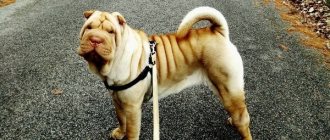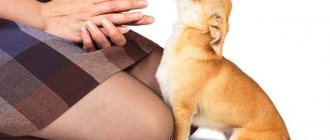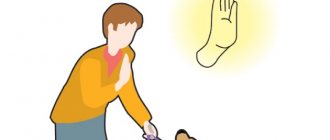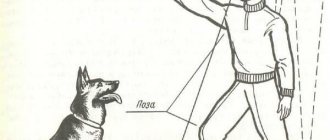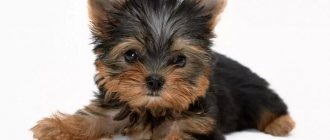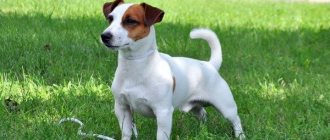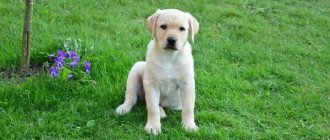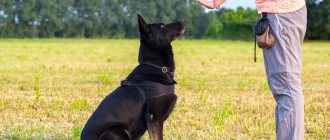Labrador as a breed developed towards the end of the 19th century, and as an independent phenotype it was officially recognized by the English Kennel Club in 1903.
A powerful, well-built dog with free movements and an active, sociable character.
Affectionate with children, an excellent gun hunting dog, with virtually no flaws.
Are they easy to train?
The Labrador Retriever is an intelligent and obedient dog, confident in its abilities.
Labradors are persistent in achieving their goals and always want to please their owner. These two qualities make the breed one of the most successfully trainable dogs. .
In Stanley Coren's rating, Labradors take 7th place out of 80 in their ability to understand a new command in less than 5 repetitions, leaving behind Rottweilers, spaniels, and schnauzers.
Can it perform security functions and protect the owner?
Labradors are one of the most loyal dog breeds and truly love the family they live with..
They also love all other people indiscriminately and nothing can make them lose faith that life is wonderful and every person passing by wishes him and his owner well.
So never and under no circumstances will a Labrador become a guard.
It will not be able to protect the owner during an attack or in some other stressful situation . The maximum that can be expected from him in such unpleasant cases is a serious, powerful bark.
According to the breed standard, these dogs should not show aggression, and breeders, when breeding and further maintaining the breed, are very careful about this quality and at the slightest hint of aggressiveness, the individual is discarded, not allowing further breeding.
Dog handlers believe that if you start training a Labrador to guard the territory or try to teach it commands from a course on protective guard service, this will inevitably break the animal’s psyche and the dog will become hysterical, uncontrollable and uncontrollable, naturally without learning security skills.
Possible difficulties
It is recommended to start working with a dog from 2 months. In adulthood, during training, many owners encounter difficulties arising from the impulsiveness of the breed. Dogs are often distracted, try to escape from classes, and prefer games.
Labradors are able to outwit the owner by luring out treats. At the same time, dogs make ideal hunters, guides, and trackers. Dogs are also capable of guarding skills, but with difficulty.
Labradors are equally trainable at any age. Able to remember a command 2-5 times.
Sometimes puppies already perform complex tasks at 3 months of age.
At what age should training begin?
From approximately the age of 1.5 months, the second period of socialization of the dog begins, which is most suitable for education and initial training, which can be considered the initial stage of training.
Positive skills and catch reflexes are developed quickly and easily.
The nervous system reacts quickly to favorable and not very favorable influences from the outside. The general level of physical and emotional activity is high, so the puppy’s activity is dominated by an indicative-exploratory reaction.
IMPORTANT!
From the age of 1.5 months, you need to carefully but persistently give the dog signals about what is allowed to do and what is not.
Even from such a small age of the puppy, the owner must constantly observe the established rules and demand that the dog follow them: if it is impossible, then it is impossible for the rest of its life, without exceptions.
For example, if you do not plan to let a 35-pound dog into your bed in the future, then this should be taboo for a one-and-a-half-month-old puppy; If you don’t want a dirty dog the size of a small calf, happy to meet you, to enthusiastically jump on your face, then you shouldn’t allow the puppy to do this either.
Education from an early age at home is the basis for strengthening the relationship between owner and dog.
Retriever bathing
Labradors are water lovers . They are famous as lifesavers at sea. Therefore, be prepared to catch your dog swimming or lying in a puddle when walking with it without a leash. If there is a pond with clean water near the walking areas, then let the dog out for a swim . If the animal has bathed in mud, then it is washed from head to toe with a special shampoo. If the animal avoids puddles, then bathing is carried out once every 4 to 6 months.
Advice! Wash your dog's paws and belly after every walk. Brush the dog every day or every other day.
Where to start training and how long you need to train
A puppy is like a small child: it needs care, affectionate but demanding education and love. From the moment a puppy appears in the house, its upbringing and training must begin with accustoming it to a name and to being handled.
It is necessary to help the puppy to be in the company of people and other pets, not to be afraid of noisy or sharp sounds, to accustom him to order and daily routine..
Already at this age, when the puppy does not yet go outside, you should begin to accustom him to wearing a collar and a leash attached to it: the owner’s task is to convey to the baby that this is not scary.
At this stage, training will not take much time: 5-10 minutes a day for each skill, while constantly confirming the need for the behavioral reactions expected from the dog with your confident, calm behavior, and the puppy will be prepared for further, more serious training.
Do not tighten the collar too tightly (2 fingers should fit under it freely) or too loosely.
Expert opinion
Kozhevin Semyon Kirillovich
Expert dog handler.
You can train, for example, using one technique as a basis. Its essence lies in the fact that in each period of a dog’s growing up and life, one dominant motive of behavior stands out, most clearly expressed at a given stage of life, which is used as a motivator during training. A choleric Labrador will actively and joyfully work for the opportunity to play with a toy and run for a frisbee; an obvious food eater will follow commands for a special treat. That is, the reward for a correctly executed command can be anything, from your favorite crackers to games and affection.
Dog appearance (standards)
Photo: https://pixabay.com/photos/dog-labrador-animal-walk-run-1873218/
Dimensions
The height of a male dog is approximately 57 cm, females are usually not much shorter, only 1 cm. The ideal weight of a male dog is considered to be 27-40 kg. Bitches are usually 5 kg lighter.
Wool
The Labrador dog has short, thick hair that is rough to the touch. The undercoat is dense and waterproof.
Colors
Today the standard provides for three colors: black, fawn, chocolate.
Moreover, different shades of these colors are allowed. For a long time, only black Labrador was popular. Dogs with other colors were simply not recognized.
Fawn-colored Labrador puppies only saw the world in 1899. Notable is the fact that the father and mother of the puppies had the generally recognized black color. The puppies attracted the attention of breeders, and dogs with this color began to be purposefully bred.
The chocolate color appeared periodically in puppies in various litters, but it aroused interest much later.
Head
The Labrador has a head with a wide skull. The animal has a blunt muzzle.
Teeth and jaws
Teeth are straight, white and healthy. Scissor bite.
Eyes
Small eyes are brown or hazel in color.
Body and limbs
The back is straight, the loin is short and strong, the chest is massive. The paws are of the same length, very strong and bony.
Tail
The dog has an interesting tail shape: wide at the base, it tapers towards the end and resembles the tail of an otter.
Rock defects
Defects are considered to be any deviations from the norms of the standard: deviations in dew and weight, long hair, cryptorchidism in males, color inconsistency, aggressive behavior.
Types of reflexes
A reflex—the nervous system’s response to stimulation—can be conditioned or unconditioned.
Unconditioned reflexes, given by nature, constant and unchanging reactions of the body, include:
- unconditioned reflexes of a newborn puppy (sucking, swallowing, crawling), helping him adapt to the world around him;
- more complex unconditioned reflexes (food, orientation, movement, search, games, sexual, parental).
Unconditioned reflexes serve as the basis for practicing conditioned reflexes, which are so necessary for training dogs..
They, in turn, are divided into natural (formed only in response to the natural qualities of the stimulus) and artificial (those formed as a result of extraneous stimuli).
The reaction to the voice and appearance of the owner is a natural conditioned reflex; it is formed naturally, without effort and does not fade for a long time.
The reaction to the sound of a command, a gesture, a whistle is an artificial conditioned reflex that is slowly formed and without constant training and proper reinforcement quickly fades away.
Dog training is based precisely on the varied use of artificial conditioned reflexes.
How to toilet train and diaper at home
As a rule, the puppy urinates immediately after sleep/play/15 minutes after eating, and before cleansing the intestines, it worries for some time, looking for a comfortable place, sometimes whining.
Having noticed that the puppy is preparing to recover, you need to quickly draw his attention to yourself with some exclamation.
The pet will react, its urges will subside for a while, and there will be an opportunity to put a diaper on it. In this case, you definitely need to be patient and wait for the correction!
Over time, he will develop the necessary reflex, and when he needs to go to the toilet, he will do it in a diaper without outside help .
How to stop jumping on people
The need to jump, as a kind of greeting ritual, is formed from puppyhood. The purpose of such jumps is to get food. That is why the puppy strives to get to the face of the owner (or another person): he jumps instinctively, just as he bites.
In such situations, some advise stopping the dog with a knee strike and squeezing its front paws. You shouldn't do this. There are much more humane and no less effective methods.
You can, together with the command “No!” or “You can’t!” extend your palm towards the animal and step forward towards it or encourage alternative behavior .
NOTE!
You need to start weaning off jumping on people from puppyhood. If the Labrador is already an adult and has not been taught to restrain his emotions, experienced dog breeders advise wearing a halter and practicing self-control.
It is possible that the Labrador, as an extremely active and cheerful dog, will need quite a lot of time for this.
Experts advise practicing endurance on many, many people, in various situations, rewarding with treats for not jumping, then the desired behavior pattern will form and the dog will stop jumping..
If the dog is on a leash and is about to jump on someone, you need to sharply pull the leash.
Feeding with natural food
If the owner chooses to feed the puppy natural food, then it is worth considering that food from the human table is not suitable; it must be prepared separately for the dog. The issue of diet planning must be approached very responsibly.
The daily amount of natural food for a six-month-old Labrador is 3-4% of its weight.
Three feedings per day are recommended. Nutrition components are distributed approximately as follows: 3/5 – meat, 1/5 – vegetables and fruits, 1/5 – cereals, 1/5 – fermented milk products.
Puppy meat should be frozen first and then cut into pieces. By-products, incl. and liver must be boiled. Jellied meat made from beef bones is very useful for puppies.
For better absorption of vegetables, you need to add any vegetable oil to them..
As treats, puppies can be given rye crackers, cheese, apples, and carrots.
It should be noted that Labradors are terrible gluttons and are always ready to beg for food, especially if it is the owner’s food.
Therefore, we need to know about a number of foods that should not be given to a dog: milk, sweets, pasta, bread, legumes, potatoes, sugar, spices, onions, garlic, radishes, grapes, raisins, salted, smoked, fried, fatty meat, tubular bones.
All this, to one degree or another, harms the puppy’s health.
Natural feeding cannot fully saturate the puppy’s body with all the necessary substances, so some supplements need to be introduced.
Since the Labrador is a large and heavy dog, it is necessary to support the puppy’s joints and bones; for this, chondroprotectors and calcium should be added to its diet.
If the dog refuses oil in its food, then vitamin A must be administered.
Sample puppy menu:
| Breakfast | Dinner | Dinner | |
| Monday | Low-fat cottage cheese + kefir | Beef+rice | By-products (heart, kidneys, udder, lung) + salad (pumpkin, zucchini, carrots, greens, beets, cabbage, apples - to choose from) + oil |
| Tuesday | Low-fat cottage cheese + sour cream | By-products (heart, kidneys, udder, lung - to choose from) + buckwheat porridge | Beef+salad+butter |
| Wednesday | Low-fat cottage cheese + bifidok | Liver + wheat porridge | Liver+salad+oil |
| Thursday | Low-fat cottage cheese + kefir + egg | Turkey+oatmeal | Offal+salad+oil |
| Friday | Low-fat cottage cheese + sour cream | Beef+buckwheat | Turkey+salad+butter |
| Saturday | Low-fat cottage cheese + yogurt | Offal+rice | Beef+salad+butter |
| Sunday | Low-fat cottage cheese + yogurt | Lean sea fish + rice + buckwheat | Fish+salad+oil |
Dry food
Balanced food ensures harmonious growth and development of the dog’s skeleton, teeth, muscles, and excellent coat condition.
Therefore, it is worth completely eliminating cheap mass market products, such as, for example, Pedigree, Chappie, etc..
Such economy class food does not meet the needs of a growing puppy’s body. It is worth choosing premium and super premium food or holistic food, choosing something that suits the puppy and will not cause allergies, digestive problems, etc.
There are many brands of acceptable dry food, such as Hill's, Royal Canin, Eukanuba, Purina Pro Plan, Acana, etc.
IMPORTANT!
When choosing food, you should pay attention to the amount of protein and fat in it: high-protein food is not suitable for a Labrador puppy; the optimal content is 22-25%.
At 6 months the puppy is already eating according to the diet for juniors . The optimal number of feedings per day is 4.
Each food package indicates the age category and a table with the consumption rate, which is calculated based on the weight and age of the puppy. But it is not an immutable truth; you should focus on your dog.
A Labrador puppy should not be too thin, but not too fat either . Excess weight is very harmful to a dog's health.
If the dog is overweight, he will have to be temporarily switched to light diet food or reduce the amount of regular food.
Often Labradors are allergic to one or another food . It can manifest itself as redness in the ears, skin rashes, and itching. In this case, you need to consult a doctor and temporarily switch to hypoallergenic food.
When deciding to feed a puppy dry food, porridge, meat, and dairy products are strictly prohibited in the diet, because... the addition of protein will upset the balance of nutrients, which can lead to kidney and liver diseases.
You can give fruits and vegetables as treats.
Feeding dry food increases your dog's need to drink, so be sure to keep the water bowl full at all times . It, unlike a bowl of food, should always be freely available to the puppy.
How to stop pulling on a leash
Most often, the reason that a Labrador pulls on the leash is the incorrect behavior of the owner, who does not understand the psychology of the animal.
When a dog pulls on the leash, it means that it is in control of the situation, not the owner, and it becomes unclear who is walking whom.
To solve this problem you need to follow the following rules:
- keep the leash loose from the very beginning;
- when moving, periodically follow the dog and at times force it to turn in the direction you want, using a treat, toy or target;
- while moving, try to constantly maintain contact with the dog with your voice, gestures, and rewards for correct behavior;
- whenever the Labrador begins to pull on the leash, stop or walk back (the dog needs to understand that as soon as it pulls on the leash, the movement towards the goal stops, it is useless to resist).
Naturally, these rules are easier to apply when the Labrador is still small . Therefore, raising a dog, including weaning it off from pulling, must begin at an early age.
You should not solve the problem of a tight leash by putting on a strict collar or, especially, a shock collar ! Labrador is not a breed that requires such extreme measures.
History of appearance
Most of us believe that the Labrador breed borrowed its name from the island of the same name, where it was born, but this is far from true.
Representatives of the breed originate from the island of Newfoundland. It is known that in the 19th century there were two breeds of dogs called Newfoundlands, only one of them was a large Newfoundland, and the second was a small one. A large Newfoundland helped fishermen drag carts loaded to the brim with fish. This dog was distinguished by its large size and long hair. The Small Newfoundland was used to directly assist fishermen: it carried nets in the water, and could, if necessary, jump into icy water to bring back fish that had fallen from the nets.
The peculiarity of small dogs was thick, water-repellent fur and webbed paws. The coat practically did not get wet, as a result of which there was no need to try to rid the dog of icicles that appeared after contact with water in a cold climate. Peculiar webbed feet helped the animal move very quickly in the water.
Their small size was also important: fishermen would not be able to take a huge dog into their boats.
Superstitious fishermen took rescue dogs on every long voyage. People believed that the presence of dogs would protect them and nothing would happen to them. If the boat was wrecked, the dogs pulled a lifeline to the shore, along which the fishermen then climbed onto land.
Scientists suggest that it is the Little Newfoundland that is the ancestor of the modern Labrador.
The dogs brought to the UK immediately attracted attention. English sports hunters began to use these dogs when hunting pheasants and partridges and described them as an excellent hunting breed.
Small Newfoundlands began to be crossed with other breeds, such as retrievers and setters. As a result, the Labrador breed appeared in the form in which we are familiar with it.
There are several versions explaining the name of the breed. According to one of them, the English “to retrieve” is translated as to find and retrieve and is used in relation to hunting dogs. That is, in the past, retrievers found shot game and brought it to the person. Nowadays, Labrador dogs mainly wear slippers for the owner and abandoned toys for children.
The only color that Labradors had at that time was black. It is quite possible that this is why they got their name, since they were somewhat reminiscent of a black “labradorite” stone.
How to teach basic commands
With the help of basic commands, the owner can control the animal everywhere - at home, on the street, in the country, on a trip.
If you don’t set grandiose goals for yourself, just a few basic commands are enough to properly raise a Labrador:
- Dog handlers say: if the dog does not follow the command “Come to me!”, consider that you do not have a dog . This command is given in a loud voice in a commanding tone, the gesture is standing facing the dog at some distance (hands pressed to the hips), raising the hand to the side to shoulder level with the palm down, and then sharply lowering it to the thigh (maybe with a light slap on the leg) . The dog must approach/run up to the owner, go around him from behind and sit at his left leg, then the command is considered completed. If the command is carried out correctly, the Labrador receives a treat.
- The command “Sit!” is given by a gesture - raising a hand or finger . At the beginning of training, the command is supplemented with a voice; later, only a gesture is used, which the Labrador should easily distinguish from other gestures. Alternatively, you can hold the treat with your thumb and middle finger, while pointing your index finger upward - this will become a gesture indicating a request for a seat. Upon completion of the correct execution of the command - a treat.
- To practice the command “Lie down!” — you need to say this command and lower your hand, previously raised to shoulder level, with your palm down (towards the dog). Correctly executed command: the dog immediately assumes a prone position (torso to the ground, front and hind legs parallel to the body).
- To teach your Labrador the prohibitive command “Fu!” (“No!”) - you need to use a strictly defined technique: first a prohibition (command), and then punishment of the animal in case of non-compliance (a strong jerk with the leash, throwing an object at the dog or in the immediate vicinity of it, for example, a rattler) ). The prohibiting command must be given precisely at the moment when the dog is ready to begin performing an undesirable action. There is no need to reward the animal for doing it.
Team "Ugh!" especially important for Labradors . They are called “vacuum cleaners”: many dogs of this breed, not accustomed to the prohibitive command “Ugh!”, retain the habit throughout their lives of picking up everything they encounter on the way and instantly eating it. The life and health of a Labrador depends on knowledge of this command.
- The command “Stop!” is no less important for a dog’s life. : with its help you can stop even a running dog in emergency situations; it will be needed when examining the pet, cleaning, putting on equipment. It is given by voice and gesture (standing facing the dog, sharply raising the hand forward with the palm up to the shoulder).
- Team "Voice!" - is given verbally with a simultaneous presentation of a gesture (waving the right hand, bent at the elbow, at shoulder level, palm forward) or snapping the fingers of the hand raised above the dog. When teaching this command, the dog must sit and be hungry. As soon as he barks, he needs to be praised and given a treat.
Worthy of a treat
The very first command that the puppy must remember is “Place”. As soon as he crosses the threshold of the house and gets acquainted with the territory, you must immediately show him this place. It doesn’t matter whether it’s a bed in an apartment or an enclosure with a booth in the yard.
In the process of exploring new possessions, he himself will wander where he needs to go. Then, with a slight movement of your hand, hold it there for a while. At the same time, say the command: “Place” several times. In the future, these steps will need to be repeated several times a day.
If a new family member accidentally enters the prohibited territory, you need to take him to the place and repeat the command. Labradors are very intelligent. In just a few days, your dog will know that it is possible to go here and not to go there. Very soon he will learn to go “to himself” on his own on command.
Every correctly performed action needs to be reinforced with a treat. The puppy should have positive feelings associated with this command. Then he will love his own corner and will not lie around anywhere. If the Labrador were human, he would probably think: “I’m lying in my place and worthy of praise and treats.”
But not everything can always go smoothly. Be sure to be patient, do not get irritated or yell, and, moreover, never hit your pet. Such treatment can negate all your further efforts. Remember that a Labrador is a dog that is trying to understand what is required of it.
Training scheme
The earlier training is started, the more successful the results of training will be.
The main thing is not to subjugate the animal through intimidation, physical punishment, or pressure, but to establish strong friendly relations with it, based on mutual trust and understanding..
That is why, before the Labrador is six months old, you need to have time to train your pet to carry out basic commands, although the obedience will not yet be clear and impeccable, but the dog will be familiar with the basic norms of behavior.
The earliest age at which a dog finds itself in its new home is 1.5-2 months. From this time it is worth starting the process of education.
Below is an approximate scheme for raising and training a Labrador:
| Puppy age | What needs to be taught |
| 2 months |
|
| 3 months |
|
| 4 months |
|
| 5 months |
|
| 6 months |
|
| from 7 months to 1 year |
|
If you stick to this schedule, by the end of the first year of life, the Labrador will become a well-mannered dog.
If the puppy cannot get used to cleanliness after 6 months, subject to proper toilet training, you need to work with your veterinarian to look for problems in the pet’s psyche or physiology.
Vaccinations for Labrador puppies are required!
By the age of two months, a Labrador is scheduled for its first vaccination . Or vaccination is carried out a little earlier, when babies are weaned from the dog (at one and a half months).
Ten days (or two weeks) they are given anthelmintic drugs. If you are planning to go for vaccination and your puppy is sick, postpone the trip.
Important! Re- vaccinate after three weeks . On the issue of vaccinations, the most important thing is not to forget to do them and consult a doctor or breeder on the slightest questions. But vaccinations are absolutely necessary.
The third vaccination is done when the dog is about a year old . And then they are vaccinated once a year. to the veterinarian for preventive examinations once every six months.
The dog also needs to periodically wormed and treated for fleas and ticks . Specific medications are prescribed by a veterinarian.
Basic mistakes when training
Many inexperienced owners make mistakes when training. The result of this is, at best, bad manners of the pet; with gross mistakes in upbringing, the animal’s psyche can suffer.
So, when training a Labrador, like any other dog, you should not:
- conduct the first classes in places with a large number of distracting stimuli - the animal will react to them, and the trainer’s actions will remain unnoticed;
- often use strong painful stimuli or physical punishment to reinforce the prohibiting command - the dog will begin to fear both the trainer and the command;
- use a prohibiting command and not back it up with influence or use it inappropriately - the Labrador will stop responding to it;
- encourage the pet until the command is fully completed;
- each time pronounce the dog’s name before giving the command “Come to me!” - the dog will get used to following the command only after it hears its name;
- every time after executing the command “Come to me!” fasten the dog on a leash and go home - the pet will begin to respond to the call as a signal to stop walking and will stop obeying;
- give the command “Near!” without backing it up with a jerk - you may not get a reaction to the command;
- give a command too loudly;
- act rudely towards a student.
Labrador is a breed that is highly trainable, and the owner of the dog can easily handle raising it himself, but it happens that for some reason the owner is unable or does not have time to understand the behavioral characteristics of dogs.
In this case, it is better to trust professionals in order to get the desired result and not harm your pet..
Tips from dog handlers
According to experienced dog handlers, Labradors are food eaters, so they learn lessons much better and faster if they receive something tasty as a reward. But you have to be careful; this breed is very smart and quick-witted; the dog can be capricious on purpose, carry out commands at full strength in order to eat as much treat as possible. You should not follow your pet’s lead; it is important to be persistent, demanding and unwavering.
You should contact professional dog handlers after your pet is eight months old. A specialist will be able to cope with even the most disobedient Labrador; commands will be carried out on demand. But in most cases, owners train their pets on their own.
